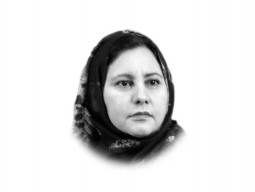
Women now represent half of the world’s university students, and that is the case in Pakistan as well. In 1993, 22 per cent of the student body in Pakistan comprised of women, while in 2011 the number had risen to 47 per cent according to the Higher Education Commission. There is a critical mass of educated females across the world, who are slowly and surely changing paradigms. This, of course, is the upside of the previous decade that we can all be proud of and need to celebrate.
The point remains how many of these female graduates are able to find jobs. There is no doubt that a country where 50 per cent of the population is left out of the labour force simply cannot progress, and estimates show that the cost of leaving women out of the economy can be as high as one per cent of annualised loss in gross domestic product. In many countries, gender inequality persists in terms of economic opportunities, earnings and productivity for women. Pakistan is no different in this respect: women comprise 75 per cent of the labour force in agriculture, essentially working as unpaid and unrecognised farm workers, while the female employment rate in industry and services is 12 per cent and 13 per cent respectively.
Economically, this translates into lower incomes and less market opportunities for female labour and the gains of education do not seem to permeate into better job options for women as a whole. There are several reasons behind the persistence of such disparities. Even though women have made phenomenal gains in higher education, the overall enrolment of girls in primary and secondary schools remains much lower than boys. Lack of access to education limits market opportunities for adult females, who then tend to seek self employment in the informal sector, where they end up working harder than men but earning less since they usually work in less profitable sectors.
In my work with female entrepreneurs in low-income communities, I have often come across many paradigm changers. These are women, who despite their lack of education or their lack of formal training have succeeded in incubating and growing their businesses. I remember the first time I met Parveen baji in a slum area of south Lahore. She was a petite, quiet woman with a deeply-lined face, which reflected years of endless struggle and belied her true age. Parveen had contemplated suicide many times, because of a husband who was a physical abuser and a marriage which had resulted in nine children. Life was hard and her lack of voice, agency and access to markets made it even harder. She wanted to change her life, but found both internal and external constraints that held her back.
Her own lack of belief in herself, combined with the time old notion that a woman’s earning is not blessed cowed her down. Her husband despite his extreme negligence was still the man of the house, he made the decisions and held complete sway over her and her children. In spite of her doubts, she decided to take a risk and start a business with a small loan after enrolling in a basic financial education course provided by Kashf. She began making beautiful quilted bed sets, which she first sold in her own community and later in other markets. Her earnings gave her respite from the past and allowed her to choose a different future for her children.
On a more macro level, we can learn several lessons from Parveen’s story. In order to promote women’s economic empowerment access to resources whether financial or capacity related becomes a prime driver. This needs to be combined with enhancing women’s access to markets, while reducing constraints that affect women disproportionately, for example, providing child care programmes, introducing career development programmes and promoting affirmative action across industries. There is also a need to equalise women’s voices within the households and increase their control over resources — these aspects need to be taken up through changes in policy and the law, while massifying access to education for both boys and girls. The enactments of the domestic violence act and the sexual harassment at the workplace bill are positive developments, and are backed by the fact that 22 per cent of the parliament comprises of women.
Both these laws certainly help to improve the constraints that women face within and outside their homes, however in the case of statutory changes it is implementation that matters and only time will tell how such laws change the environment for women in the work force. We as a country need to do much more for women than we have done in the past 65 years — the good news is we know what needs to be done.
Published in The Express Tribune, March 8th, 2012.















COMMENTS
Comments are moderated and generally will be posted if they are on-topic and not abusive.
For more information, please see our Comments FAQ